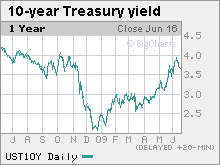Bonds mixed as inflation woes abate
Long bonds erase earlier gains. Fed purchases $7 billion in debt.
NEW YORK (CNNMoney.com) -- Treasury prices were mixed Wednesday as a five-day day rally cooled, with longer-term bonds erasing earlier gains, as stocks moved higher amid tempered inflation worries.
The government has been on a spending spree to fund stimulus programs aimed at jumpstarting the economy, and that unprecedented pace of spending had been raising inflation fears.
But a government report on consumer prices released Wednesday indicated inflation is not a near-term threat, echoing the government's report released Tuesday on wholesale prices.
Treasury prices had mostly risen for the past five days on a weaker stock market. But the bond rally ran out of steam as equities turned higher late Wednesday after an upbeat inflation report and President Obama's revealing of a plan for an overhaul of financial market regulation.
Investors tend to flee the safety of government debt when the stock market rises, lured by the possibility of higher rewards.
The benchmark 10-year note fell 5/32 to 95-14/32, and its yield jumped to 3.68%, still well below the 4% threshold the yield hit last week. Bond prices and yields move in opposite directions.
The 30-year bond sank 15/32 to 95-27/32, and its yield ticked up to 4.51%.
The 2-year note ticked up 2/32 to 99-15/32, and its yield edged down to 1.16%. The yield on the 3-month rose to 0.18% from 0.17%.
Inflation in check. The Consumer Price Index, the Labor Department's key measure of inflation, has fallen 1.3% over the past year, marking the largest year-over-year decline since April 1950. On a monthly basis, CPI rose 0.1% in May, shy of the 0.3% rise that was expected.
Inflationary concerns rise in tandem with large increases in the so-called "core" readings, which exclude volatile energy and food costs.
Conversely, deflation is characterized by broad-based, continued declines in subsectors.
With inflation in check, the Federal Reserve can feel more confident leaving its key lending rate at a target range of zero to 0.25%.
"Monetary policy is not an issue at this time," said Nick Kalivas, vice president of financial research at MF Global, in his daily research note. "The labor market will need to strengthen and capacity use will need to be increased before the Fed is ready to raise rates."
Buyback plan. The Federal Reserve repurchased $7 billion worth of debt maturing between May 2016 and May 2019 on Wednesday as part of its debt buyback campaign.
On Tuesday, debt prices rallied after the first scheduled debt buyback for the week where the government bought $6.5 billion of debt that matures between May 2012 and November 2013.
The government embarked on its $300 billion quantitative easing program in March. The goal was to create demand in the marketplace, keeping a lid on rising yields.
However, creating demand in a marketplace overwhelmed with supply has proven a challenge. Yields have dipped in the last few sessions, but are still higher than they were in March. Higher yields mean higher lending rates, particularly for home mortgages.
The government continues to sell debt to fund its rescue for the economy. On Thursday, the Treasury will announce the size of the 2-year, 5-year and 7-year auctions scheduled for next week. Last week, the market absorbed $65 billion in debt.
The Federal Open Market Committee meets June 23 and 24, and the market is anticipating what the Fed might announce.
Lending rates: Bank-to-bank lending rates have plunged to record lows in recent weeks, a good sign for the once-frozen pipelines of credit.
The three-month Libor held steady at a record low of 0.61%, according to data on Bloomberg.com. The overnight Libor rate was also unchanged at 0.26%.
The London Interbank Offered Rate -- or Libor -- is a daily average of rates that 16 different banks charge each other to lend money. The closely watched benchmark is used to calculate adjustable-rate mortgages. More than $350 trillion in assets are tied to Libor. ![]()



